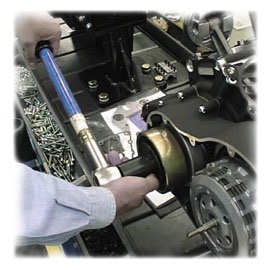








There are three basic styles in which the wrench can signal achieving torque, either by a “click,” “break,” or “slip.” Each of three wrench styles has a specific purpose and utility. When you decide to spend the money for one, it’s important that you select the torque wrench that will do the job properly and not generically and learn how to use the torque wrench properly.
Click Wrenches Wrenches typically emit a loud audible "click" when the set torque is reached. Most click type wrenches break about 3 degrees after set torque is reached and then become positive. This positive action can cause over-torque conditions. Proper use and maintaining is required so that operators stop pulling the moment the click sound is heard or felt. Mountz offers adjustable torque wrench models.
Break-Over Wrenches are essential to limiting the amount of torque applied to an assembly or fastening application. Break-over torque wrenches, typically deflect 20-90 degrees on torque delivery, thus indicating torque has been reached. Many break-over wrenches require manual resetting, while others have an automatic resetting feature. Mountz offers a small torque wrench models.
Dial Wrenches are robust and durable. Dial wrenches are typically used as a quality control instrument to verify or monitor torque. However, some customers find them a resourceful production tool.
Cam-Over Wrenches are perfect for maintenance and production applications where over-torque conditions are not tolerated. Each cam-over wrench utilizes a ball and lobe design allowing the wrench to slip free when torque is reached, eliminating the possibility of over-torque. Cam-over wrenches are non-length dependent and effectively take the guesswork out of torque delivery. The use of cam-over wrenches takes operator influence out of the torque equation and offers more accurate and repeatable results than a standard click type wrench.
RF, COAX & SMA Torque Wrenches improve control of the fastening process by reducing the risk of a connector from being under and overtightened. The correct tightening of a RF, COAX and SMA Connectors used in RF cabling applications is essential to ensure optimum performance. This is particularly important in high frequency applications using stainless steel or beryllium-copper bodies. SMA torque wrenches commonly have open-ended spanner or roller grip head configuration.